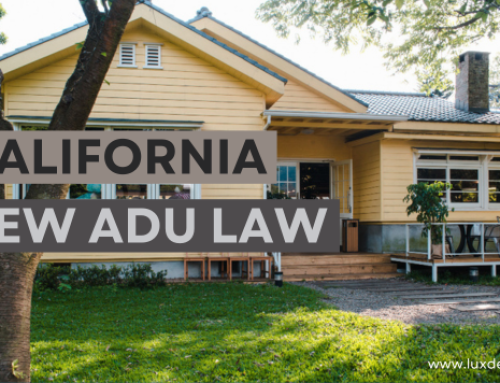Accessory Dwelling Units, commonly known as ADUs, represent a growing trend in modern housing. These structures, often referred to as granny flats, in-law units, or backyard cottages, are secondary housing units on a single residential lot. ADUs can be attached to an existing home or built as a standalone structure. They offer a versatile solution for expanding living space, accommodating extended family, generating rental income, or even creating a dedicated home office.
The rise in popularity of ADUs is partly due to urban housing challenges, including the need for affordable housing options and the desire for more flexible living arrangements. As cities become denser and real estate prices continue to soar, ADUs offer a practical solution for making the most of existing residential spaces.
Contents
- The Importance of Material Selection in ADU Construction
- Emphasizing Sustainability and Affordability
- Understanding Different ADU Construction Materials
- Wood Framing
- Steel Framing
- Concrete and Brick
- Prefabricated Materials
- Sustainable Building Materials for ADUs
- Criteria for Sustainable Materials
- Benefits of Sustainable Materials
- Types of Sustainable Materials
- Practical Considerations in Material Selection for ADUs
- Balancing Cost and Sustainability
- Assessing Local Availability and Sourcing
- Long-Term Maintenance and Durability Concerns
- Compliance with Local Building Codes and Regulations
- Conclusion
- Key Takeaways
The Importance of Material Selection in ADU Construction
When it comes to building an ADU, one of the most critical decisions involves selecting the right construction materials. This choice impacts not just the initial ADU construction timeline and costs but also the long-term sustainability, durability, and maintenance of the unit. The materials used in constructing an ADU determine its ability to withstand local weather conditions, its energy efficiency, and its overall aesthetic appeal.
Moreover, the choice of materials has significant implications for the environmental footprint of the ADU. With increasing awareness of climate change and environmental degradation, there is a growing demand for building practices that are not only efficient and cost-effective but also environmentally responsible.
Emphasizing Sustainability and Affordability
In the context of ADUs, sustainability and affordability are two key factors that go hand in hand. Sustainable materials are those that have a lower environmental impact, either through reduced energy consumption during production, the use of renewable resources, or their recyclability and durability. Using sustainable materials can lead to energy savings, reduced waste, and a healthier living environment.
Affordability is equally crucial. The cost of construction materials directly affects the overall expense of building an ADU. For many homeowners, the goal is to build a functional, aesthetically pleasing ADU without breaking the bank. Therefore, finding materials that balance cost with environmental responsibility and long-term durability is essential.
Also Read: How Much Does It Cost to Build An ADU in Los Angeles?
In this article, we will explore various construction materials suitable for ADU construction, focusing on how they align with sustainability and affordability goals. We will delve into the pros and cons of different materials, offer insights into sustainable building practices, and provide practical advice for those looking to embark on their ADU construction journey.
Understanding Different ADU Construction Materials
When constructing an Accessory Dwelling Unit (ADU), choosing the right materials is crucial for balancing cost, sustainability, and longevity. Each material comes with its unique set of advantages and disadvantages. Let’s explore some of the most common materials used in ADU construction.
Wood Framing
Pros:
- Inexpensive: Wood is generally more affordable than many other construction materials, making it a budget-friendly option for ADU construction.
- Easy to Work With: Wood’s versatility and ease of handling make it a popular choice among builders. It can be easily cut, shaped, and attached, which simplifies the construction process.
Cons:
Prone to Termite Damage and Rot: Wood is susceptible to damage from termites and can rot when exposed to moisture over time, which may increase maintenance costs.
Fire Risk: Being a combustible material, wood poses a higher fire risk compared to non-combustible materials like steel or concrete.
Steel Framing
Pros:
- Durability: Steel offers superior strength and longevity, making it an excellent choice for a structure that will last for decades.
- Resistant to Termites and Rot: Unlike wood, steel is impervious to termite damage and rot, reducing the need for frequent repairs.
- Non-Combustible: Steel’s fire-resistant qualities make it a safer option in terms of fire safety.
Cons:
Higher Cost: Steel framing can be more expensive than wood, both in terms of material costs and labor, as it often requires specialized skills and tools.
Specialized Tools Required: The construction process with steel framing demands specific tools and expertise, which can add to the overall cost and complexity of the project.
Concrete and Brick
Pros:
- Strength and Durability: Concrete and brick are known for their strength, making them ideal for a sturdy and long-lasting ADU.
- Resistant to Termites, Rot, and Fire: These materials are not susceptible to termite damage or rot, and their non-combustible nature provides excellent fire resistance.
Cons:
- Heavy and Requires Solid Foundation: The weight of concrete and brick necessitates a strong foundation, which can add to the complexity and cost of construction.
- More Difficult to Work With: Working with concrete and brick requires specific skills and tools, and the process can be more labor-intensive compared to wood or steel framing.
Prefabricated Materials
Pros:
- Cost-Effective: Prefabricated materials can be more affordable than traditional building materials, as they are manufactured in a controlled environment, reducing labor costs and waste.
- Easy to Transport and Assemble: These materials are designed for easy transportation and quick assembly, which can significantly shorten the construction timeline.
Cons:
- Potential Lack of Durability: While prefabricated materials are improving in quality, some may not offer the same durability as traditional materials.
- Limited Customization Options: Prefabricated units may offer fewer customization options, which could be a drawback for those seeking a highly personalized ADU.
In summary, the choice of construction materials for an ADU depends on a variety of factors including budget, desired durability, maintenance considerations, and personal preferences. Understanding the pros and cons of each material can help homeowners make informed decisions that align with their goals for their ADU project.
Read More: How Big Can an ADU Be in Los Angeles?
Sustainable Building Materials for ADUs
In the quest to build more environmentally friendly and sustainable ADUs, selecting the right building materials is paramount. Sustainable materials not only minimize environmental impact but also offer long-term benefits for homeowners and the community. Let’s delve into the criteria for sustainable materials, their benefits, and some examples of sustainable materials suitable for ADU construction.
Criteria for Sustainable Materials
- Locally Sourced: Materials sourced locally reduce the carbon footprint associated with transportation. Local sourcing also supports the local economy and ensures materials are suitable for the local climate.
- Recyclable: Materials that can be recycled or are made from recycled content help reduce waste in landfills and lower the environmental impact of new material production.
- Durable: Long-lasting materials reduce the need for frequent replacements, thereby conserving resources and reducing waste over time.
- Reusable: Materials that can be repurposed at the end of their life cycle for the same or different applications contribute to a circular economy, reducing waste and resource consumption.
- Made from Renewable Sources: Materials that are renewable, such as those grown or harvested sustainably, ensure minimal environmental depletion and a smaller carbon footprint.
Benefits of Sustainable Materials
- Cost Efficiency: Sustainable materials can be more cost-effective in the long run due to their durability and low maintenance requirements.
- Energy Efficiency: Many sustainable materials offer better insulation and energy efficiency, reducing energy costs and environmental impact.
- Environmental Protection: Using sustainable materials helps in conserving natural resources, reducing pollution, and mitigating climate change.
- Waste Reduction: Sustainable building practices often involve reduced waste production, both in the construction process and through the lifecycle of the building.
- Healthy Living: Materials that are non-toxic and natural contribute to better indoor air quality and a healthier living environment.
- Economic Boost: The growing demand for sustainable materials can stimulate the green economy, creating jobs and supporting sustainable business practices.
Types of Sustainable Materials
- Bamboo: Known for its rapid growth and renewability, bamboo is a strong, lightweight, and versatile material. It’s ideal for flooring, framing, and decorative elements.
- Composite Wood: Made from recycled wood fibers and plastics, composite wood is durable and resistant to rot and pests. It’s suitable for structural components and decorative finishes.
- Straw Bales: Straw is an agricultural byproduct that offers excellent insulation properties. Straw bale construction is ideal for walls, providing natural temperature regulation.
- Sheep’s Wool: As an insulation material, sheep’s wool is natural, renewable, and has excellent thermal and acoustic properties.
- Rammed Earth: This involves tamping down earth mixed with natural binders. Rammed earth walls are durable, thermally efficient, and aesthetically pleasing.
- Recycled Steel: Utilizing recycled steel reduces the need for new raw material extraction. It’s durable, strong, and suitable for framing and structural components.
Practical Considerations in Material Selection for ADUs
Selecting the right materials for an Accessory Dwelling Unit (ADU) is a multifaceted decision that involves more than just aesthetics and initial costs. Homeowners and builders must consider various practical aspects to ensure the ADU is sustainable, cost-effective, and compliant with regulations. Here are key considerations to keep in mind:
Balancing Cost and Sustainability
- Initial Investment vs. Long-Term Savings: While sustainable materials may have a higher upfront cost, they often lead to long-term savings through energy efficiency, durability, and reduced maintenance costs. It’s important to evaluate the lifecycle cost of materials, not just the initial purchase price.
- Energy Efficiency Incentives: Some sustainable materials may qualify for rebates, tax credits, or other incentives, which can offset the initial higher costs. Researching local and federal incentive programs can provide financial benefits.
Assessing Local Availability and Sourcing
- Local Climate Suitability: Materials should be appropriate for the local climate. For example, materials that are excellent for insulation in cold climates might not be suitable for hot, humid areas.
- Supporting Local Economy: Sourcing materials locally not only reduces transportation emissions but also supports local businesses and economies. It can also ensure quicker availability and potentially lower transportation costs.
- Supply Chain Considerations: Evaluate the reliability and sustainability of the supply chain for chosen materials. This includes considering the practices of suppliers and manufacturers in terms of their environmental and social impact.
Long-Term Maintenance and Durability Concerns
- Durability of Materials: Select materials that are known for their longevity and resilience to wear and tear. Durable materials, while possibly more expensive upfront, can reduce the need for frequent repairs or replacements.
- Maintenance Requirements: Consider the level of maintenance each material requires. Some sustainable materials may need more regular maintenance, which could impact long-term costs and the environmental footprint.
Compliance with Local Building Codes and Regulations
- Building Codes: Ensure that the chosen materials comply with local building codes and regulations. Non-compliance can lead to costly modifications and legal issues.
- Permitting Process: Understand the permitting process for ADUs in your area. Some materials or construction methods might affect the ease of obtaining necessary permits.
- Zoning Laws: Be aware of any zoning laws that might affect material choices, such as restrictions on certain types of construction or materials in your area.
- Future-Proofing: Consider future changes in building codes, especially related to sustainability and energy efficiency. Selecting materials that exceed current standards can be a wise choice for future compliance and adaptability.
Conclusion
Building an Accessory Dwelling Unit (ADU) presents a unique opportunity to create additional living space that is not only functional and aesthetically pleasing but also environmentally responsible and cost-effective. The journey of constructing an ADU begins with a critical decision: selecting the right construction materials. This choice has far-reaching implications, impacting everything from the unit’s sustainability and affordability to its long-term maintenance and compliance with local regulations.
Key Takeaways
- Material Selection Matters: The choice of construction materials for an ADU should balance factors like cost, sustainability, local availability, and long-term durability. Whether it’s traditional wood framing, innovative recycled steel, or natural materials like bamboo and rammed earth, each option carries its own set of benefits and challenges.
- Sustainability as a Priority: Emphasizing sustainable materials is not just an environmentally conscious decision but also a practical one. Sustainable materials can lead to cost savings over time, contribute to healthier living environments, and reduce the ecological footprint of the construction process.
- Navigating Practical Realities: Practical considerations such as local building codes, climate suitability, and maintenance requirements play a crucial role in material selection. Understanding and navigating these aspects is essential for the successful completion and long-term viability of the ADU.
- The Bigger Picture: Building an ADU is more than just an addition to a property; it’s a contribution to a more sustainable and efficient use of residential spaces in urban environments. By choosing the right materials, homeowners can make a positive impact on their community and the environment.






